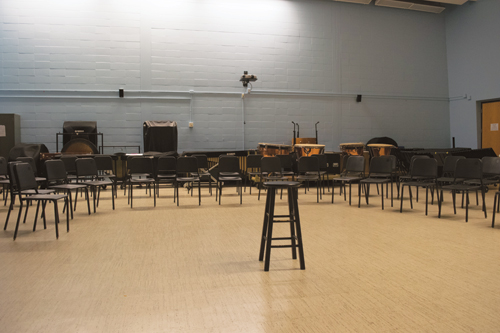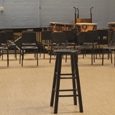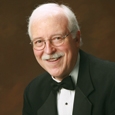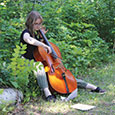
Rehearsal time is a valuable commodity. We only have a limited amount of time with our students each day, and it is essential to make the most out of the time that we have. Below are a few ideas that will lead to successful, productive, and meaningful rehearsals.
Repertoire
Choosing high-quality repertoire is one of the most important choices that we make during the year. It will become the basis for the curriculum and will dictate what and how we rehearse. To that end, the music we rehearse should be music of consequence. Working on good music is what makes the time valid. If you choose music of no consequence, rehearsal time will not have lasting value.
When selecting literature for rehearsal and performance, students should have the opportunity to learn and perform the masterworks of the medium; a steady diet of what’s new is not always the best path. Begin with transcriptions, and explore compositions from all historical periods up to and including contemporary and experimental works that stretch the ensemble’s knowledge of modern styles. Select literature with varied forms, structures, textures, and timbres, while avoiding cookie-cutter formula pieces.
Most importantly, select repertoire that is musically and technically appropriate for your ensemble. Consider the technical and rhythmic demands, instrumentation, ranges, scoring and solo expectations that are required for a successful performance. In other words, American Overture for Band by Joseph Wilcox Jenkins is a poor choice unless you have an accomplished horn section.
While it is important to challenge your ensemble technically, it is not wise to only choose music at your ensemble’s technical frontier. Remember that technique is a means to a musical end and not an end in itself. As a general rule, if most of the rehearsal stops and corrections are for fixing pitches and rhythms, students will never have the opportunity to think about the musical and expressive aspects of the music – tone, intonation, blend, balance, and phrasing. I am a great believer in legato cantabile pieces. Every program needs a slow change-of-pace piece, so if you play one, almost immediately students can handle the notes and the rhythms, so all of the time is spent on beautiful tone, phrase shape, and intonation.
Sightreading is a good gauge for a work’s difficulty. If students cannot sightread a piece without falling apart frequently – if not bar to bar then phrase to phrase – it is too difficult. Although it can be tempting to program something at the edge of students’ ability, by the time you get to the point where they can play through it, all you have dealt with are buttons and rhythms, and students will be bored. Every piece has a shelf life. You can only get so much out of a piece of music, and then you need to move on. At some point in time, students will get bored with it, no matter how great it is.
Unit Study Compositions
A unit study composition is an exemplary work from which substantial information can be pulled. More than learning the notes and rhythms, a unit study approach allows the opportunity to teach and learn about the selected work’s form and style period along with biographical information about the composer. For example, the selection of Variations on a Korean Folk Song by John Barnes Chance as a unit study composition teaches theme and variations form, melodic inversion, metric modulation, and the pentatonic scale, plus details concerning an important American composer. A unit of study might have handout materials that go with it. For example, I always had a biography of the composer and how he came to write the piece. I also gave students the vocabulary – all the terms used in the piece. This is often going to be Italian, but define it for the students.
I would recommend one unit study composition per concert or per grading period. Either way, this is a piece that you delve into more deeply than others, so it should be chosen wisely; a unit study piece is unlikely to fall on the lighter end of a concert program. With my top band those would be masterworks like the Hindemith’s Symphony or Symphonic Metamorphosis or Persichetti’s Symphony. With younger bands, that was a little more problematic. You can get people to agree on masterworks at the difficult end, but less so on the easy end; it’s more a matter of what you like. I tried to choose pieces that had stood the test of time and that I had seen on other people’s concert programs.
You can also build a unit of study around selected topics, such as compound rhythms, intonation, or texture. In my freshman curriculum I always had a unit on meter, during which I made sure that everybody knew what the top and bottom numbers of the time signature meant. We came up with all the different simple and compound meters so students understood the mathematics. I had a number of units like that each year.
Score Study
Conductors should have a thorough understanding of the score before the first rehearsal. It is inefficient to learn the score during class because students, in the absence of information from the teacher, will problem-solve on their own, and style, dynamics, and even fingerings will be random. By the time you figure out what you want, students will have made hundreds of musical, technical, and interpretive decisions, and you will spend much valuable rehearsal time unlearning and relearning the material, which will take twice as long and would be a terrible waste of time and energy. Instead, use a two-tiered approach to score study.
First, using a spiral-based approach, begin with general aspects of the score moving progressively towards ever-increasing musical and structural specifics to discover what makes the piece work. I learned the spiral-based approach when I was at Northwestern. It is an idea that the curriculum in music primarily consists of repeating the fundamental ideas of melody, harmony, rhythm, texture, and form with ever-increasing complexity and depth. Some subjects work best with an add-on curriculum. Mathematics is usually that way; you learn an idea, use that idea, and then move on to something more advanced based on the previous idea. Spiral-based curriculum differs in that you continue returning to fundamental ideas. For example, after learning about intervals, rather than moving on to something else, you stay with intervals, stacking more and more of them to produce triads, then seventh chords, then extended harmonies. It is possible to build a substantial program of study from a spiral-based approach.
The second aspect of score study is anticipating problems that may occur in rehearsal. Identify the technical and rhythmic trouble spots where the students may need your help. A quick word of advice, such as, “Clarinets, watch for the awkward break,” or, “Oboes, use the forked fingering for the F in measure seven” goes a long way toward students getting it correct the first time. If you ignore it, students will come up with any easy solution they can find. Then they have to unlearn that and relearn the correct technique, and it takes at least twice as long than it would to just remind them to do it correctly the first time.
Although it is essential that conductors understand instrumental pedagogy well enough to anticipate production difficulties students will face and have a plan to help them, this goes beyond the technical limitations of an instrument and into discovering what makes a particular passage difficult and how it can be fixed. For example, in Incantation and Dance, bass and contrabass clarinet players rarely struggle with the eighth-note passages in their soli section but often miscount the long notes. That’s something experienced conductors can anticipate and why it is so important to learn a piece and discover as many troublesome spots as possible before the first rehearsal.
An easy way to address a potentially troublesome rhythm is to build a warmup out of it. Then, when students encounter it in the music, they are more likely to play it correctly. I did a unit of study on this with my students, too. I called it “Exemplar Rhythms” and would have a different one each day. After we played it in warmups, I would hint, “We’re going to sightread a piece at the end of rehearsal, and you may find that rhythm there.”
The better you know the score, the less dependent you are upon it. Remember that the ultimate score study goal should to carry in your mind and ear an ideal performance model for the work. Although ear training is essential for targeting and correcting errors, it is worth noting an ear training exercise that John Paynter taught me many years ago also works well for score study: when you look at music, try to imagine how it would sound. When you listen to music, try to imagine how it would look if it were written out. Some refer to this approach as developing the seeing ear and the listening eye, and it will help both score study and rehearsal efficiency.
Planning
Thorough planning will help you get the most out of each rehearsal, and this planning starts with long-term preparation. The most important aspect of long-term planning is picking repertoire. During summer, select and begin to study the major repertoire for the following year. It is a good time to develop material for a unit study composition, or if you are using a rotation of unit study compositions, it is a good time to update your material. The summer is also a good time to write new units of study on a variety of topics that will be presented during the school year. Researching resources, developing student handouts and finding good listening examples can all be done when the schedule is less intense. The school year gets extremely busy, and these types of preparations may not get done as the year unfolds.
Once you have a sense of the whole year, you can more intelligently break it into smaller bites and greater detail, starting with block-of-time planning. This more detailed planning can be done either by grading period or from concert to concert. At this stage, more major details are covered, including knowing not just the important pieces for the year but most or all of the concert programs. A couple pieces for the spring concert might be undetermined, but the first couple concerts should be pretty well in hand. This is important because score study is important. A piece should not be put into rehearsal until the conductor has it prepared. To do otherwise is like malpractice. Nobody would trust a surgeon who is surprised to learn his patient has a heart and lungs.
Next comes weekly planning. This is a detailed sketch of what you intend to accomplish in rehearsal that week. Decide what selections need work and how much time needs to be set aside. Also, decide what units of study will be included in the week’s menu. Some like to plan in terms of daily or weekly themes. The focus for a given week could be anything from building better balance to the differences between monophonic, homophonic, and polyphonic textures.
I once heard someone say “Don’t be the only person in the room who knows what to do,” but many teachers make that mistake all the time by starting rehearsal without posting a plan. A plan gives students, especially percussionists, the chance to collect everything they need to be ready when you are.
Additionally, in a university, when a rehearsal schedule is posted for the week, students know what to practice. It is strange how few high- or middle-school students receive that same warning. The schedule for the following week could be passed out on Friday or posted on an information board or the ensemble’s website. If students know that substantial percentage of next week’s rehearsal time will be spent on one piece, they might practice it. Knowing the plan even a day ahead gives students an opportunity to prepare. Telling students what you are going to rehearse and when you are going to rehearse it will help to promote better practice habits, accomplish more in rehearsal each day, and develop exactly the behavior you want older players to have.
Lesson Plans
Lastly, conductors, particularly young conductors, should develop comprehensive lesson plans for each rehearsal. This is important because although an experienced teacher carries many ideas into a rehearsal, a young teacher doesn’t have that bag of tricks yet. A good lesson plan will include what the students should know or be able to do as the result of the rehearsal. It should also have guidelines on how the teacher will evaluate the effectiveness of the rehearsal. These ought to be measurable and observable. Most importantly, a comprehensive lesson plan should include a step-by-step sequence of events as the rehearsal unfolds. This section should include enough explicit detail that anyone reading the rehearsal plan (such as a substitute teacher or school administrator) would be able to follow the plan and understand the steps that are being taken to achieve the listed objectives. Many find it helpful to budget the amount of time that will be spent on each part of the rehearsal. Lesson plans can be designed in advance around unit study compositions. An excellent resource for this approach is Blueprint for Band by Robert Garofalo.
Following each rehearsal or at the end of the school day, take time to evaluate the rehearsal for subsequent planning. Consider what worked, what did not work and what needs more attention going forward.
Communication
We all tend to talk too much in rehearsal, repeating and embellishing when it is unnecessary. Remember that students want to play their instruments. Do not lecture; when you stop to make a correction, say what needs to be said and move on.
Young teachers should plan how they are going to say things. It is helpful to develop a rich rehearsal language that clearly and concisely describes the desired musical behavior, and the key to excellent rehearsal language is encouraging students to listen – call their attention back to the music and the desired sounds. Phrases like “listen for” and “be aware that” work well. In addition, comments should always be specific. For example, do not say “you’re out of tune” or “that rhythm is wrong.” Such statements by themselves rarely produce a desired change. Instead, be specific. Identify both the error and the needed correction.
Finally, always define and use correct musical terms. The members of my freshman band came from six different schools, so one of my first quarter goals was to develop a common base of information, so every time I used a vocabulary word, I would ask what it meant. One of my favorite phrases was “What’s the musical behavior here?” “What’s the musical behavior for legato cantabile?” Students can quickly learn to say exactly what you want them to say, then the next step is to get them to play it that way.
After you stop to make a correction, don’t use a count-off system to restart, it will waste rehearsal time. Instead, encourage your ensemble to watch you and read your preparation gesture. If this is new to the ensemble, just say “watch me” or “read the gesture” for a few times until the habit is established. Insisting that the ensemble watch you instead of listening to your count-off will encourage visual communication. The time saved here will be significant over the course of a rehearsal.
Students can easily be conditioned to observe and react to your conducting gestures, but this kind of communication will not happen automatically. You will need to develop this responsiveness in your ensemble during rehearsal. There is no magic moment where this can happen; it will work at all ages, even with beginners. In fact, the sooner, the better.
Encourage eye contact from your students and remember that it goes both ways. Keep your eyes out of the score and connected to the ensemble as much as possible. If a student has a solo and is looking down at the music when you cue, stop. Tell the student to watch you for that entrance. That’s how you teach for that. Cymbal players especially benefit from learning this. They may have to count 70 bars of rest before a crash. It may be that they have gathered in the moment because they listened to what was going on before it, but a change of venue (such as from the rehearsal room to the auditorium) may prevent them from hearing as clearly as they could in the rehearsal room, and a cue will let them know where they play. The same is true for bass drummers. Frank Ticheli’s Vesuvius has a moment like that at the end. There is a 7/8 section with an important bass drum hit, and as a conductor I would make eye contact with him a whole measure early to make sure he got it right. Cuing is more important the younger a player gets.
This applies to sections, too. It can be easy to only look at the first chair player for a section entrance, and it is good to catch the first chair player, but it is better to look up and down the section, especially if there is a student notorious for putting his horn up late. When you teach this kind of communication, early entrances go away, missed entrances go away, and students perform with greater confidence. Making frequent eye contact with your students during rehearsal and performance, perhaps with a smile of encouragement on your face, can be a powerful learning tool.
Another example of how you teach for it is if the band is playing too loudly and you want it softer, ask students (loud voice) “Am I conducting like this—” (softer voice) “—or like this?” If they say you are conducting softly, ask “Well, what do I want, then?” You are building in them a reaction to gesture by looking the way the music sounds. This is an H. Robert Reynolds notion. He would say “Be the music,” and the idea is that you want to look like the music sounds. If the music is gentle, you don’t want to be angular. If the music is rhythmic and dramatic, you don’t want a soft rebound.
An often overlooked aspect of conducting is sharing the responsibility for pulse with the ensemble. Many conductors fall into the trap of thinking that their job is to be a metronome, but as an ensemble’s listening skills develop, the group can usually stay together even if you stop conducting. Try it sometime; by the end of the first year of band, you can have an elementary band that you can stop conducting while students keep going successfully. I would stop conducting in rehearsal routinely. Students knew that, and they listened more when it happened. A conductor gives a lot of information. When I stopped, I would look like I was really listening – a little gamesmanship on my part – and students knew that meant to keep playing. Students started listening closely for the core of that pulse, and they almost always got tighter. When you share pulse responsibility with students, their listening will be more directed and it will free you to cue and shape phrases, and there will be fewer stops for pulse and tempo issues.
Clear and intentional conducting skills will save valuable time in rehearsal. If you can show the students what you want through your gestures, you don’t have to stop and explain things. When there are fewer stops, much more can be accomplished. One of the most valuable tools available to use is a video recording device. Regularly record and observe your conducting to see whether your gestures communicate what you intend.
Although there is no such thing as the perfect rehearsal, these ideas will lead to efficient and successful rehearsals that will give you a sense of satisfaction and your students a sense of accomplishment. When students regularly leave rehearsal with good feelings, they are more likely to look forward to the next rehearsal and are more likely to sign up for class next year.






